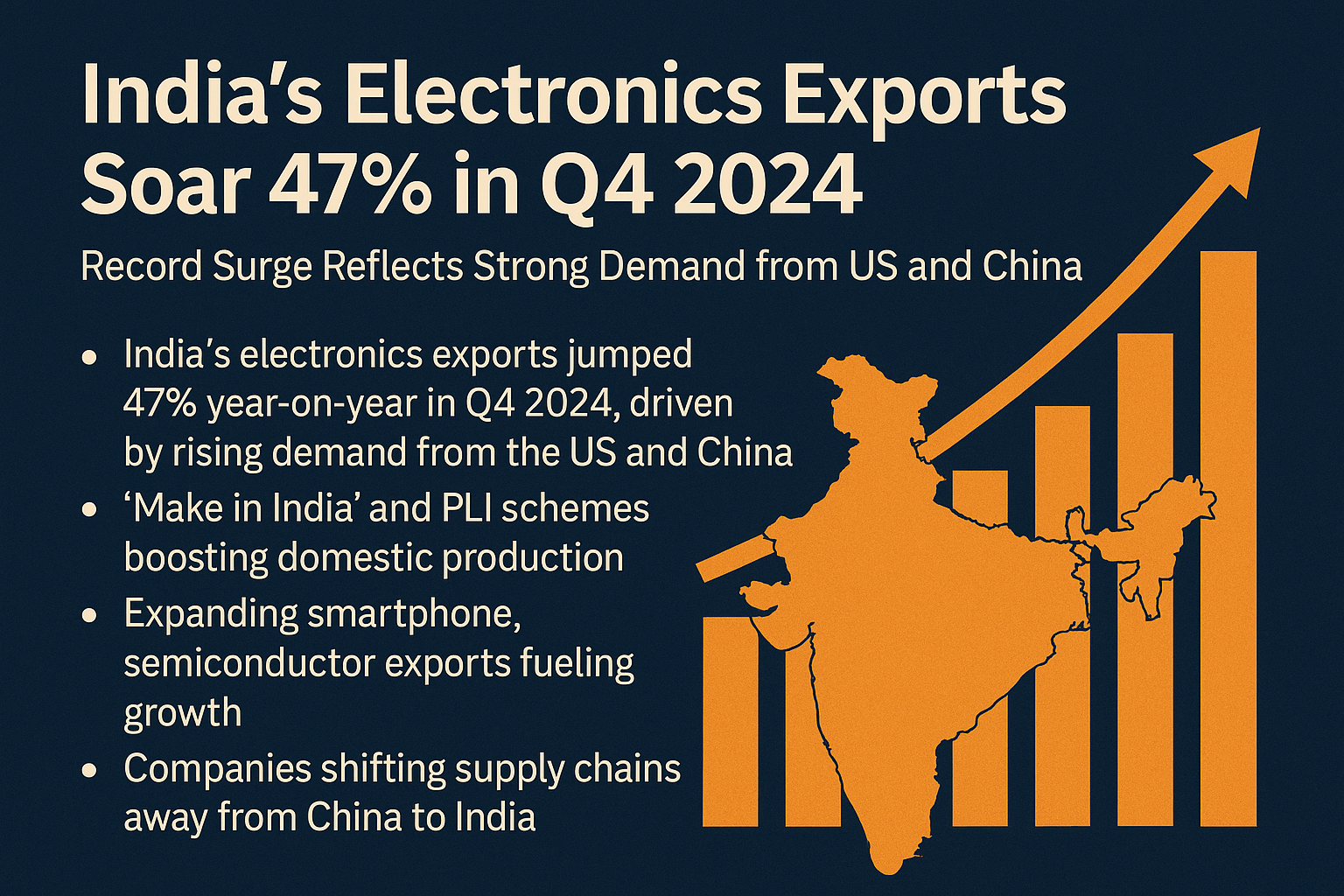Now Reading: India’s Electronics Export Industry Witnesses Unprecedented 47% Growth in Q4 2025: Global Demand, Government Policies, and Strategic Shifts Drive Trade Surge
-
01
India’s Electronics Export Industry Witnesses Unprecedented 47% Growth in Q4 2025: Global Demand, Government Policies, and Strategic Shifts Drive Trade Surge

India’s Electronics Export Industry Witnesses Unprecedented 47% Growth in Q4 2025: Global Demand, Government Policies, and Strategic Shifts Drive Trade Surge
India’s Electronics Exports Surge 47% in Q4 2025: A Deep Dive Into a Manufacturing Breakthrough
India’s journey toward becoming a global electronics manufacturing hub has taken a dramatic leap forward in the first quarter of 2025. According to the Ministry of Commerce and Industry, electronics exports grew by a staggering 47% year-on-year in Q4, pushing the total export value past ₹1.12 lakh crore (approx. $13.4 billion USD). This surge signals a strong revival of India’s export economy, supported by global market dynamics, rising foreign investment, and proactive government initiatives.
This phenomenal growth is being recognized as a defining milestone for India’s position in the global electronics supply chain, long dominated by China and Southeast Asian economies.

How India Got Here: A Decade in the Making
India’s electronics manufacturing revolution did not happen overnight. It is the result of over a decade of focused policy-making, strategic international partnerships, and massive public and private investments.
Key policy drivers include:
- ‘Make in India’ initiative (launched in 2014)
- Production Linked Incentive (PLI) Scheme for large-scale electronics manufacturing
- Electronics Manufacturing Clusters (EMC) program
- Tax rebates and subsidies for exporters
- FDI relaxation in the technology sector
These efforts have transformed India from an import-heavy electronics market into a rapidly growing production and export powerhouse.
Global Context: Why the World Is Buying from India
The global electronics market has undergone a tectonic shift post-pandemic. Businesses are increasingly diversifying supply chains to reduce dependence on China, due to rising labor costs, geopolitical uncertainty, and stricter U.S.-China trade restrictions.
India has seized this moment strategically:
- Labor costs remain competitive
- Massive domestic market justifies local production
- Western companies (Apple, Samsung, Dell, HP, Foxconn) are investing billions into Indian operations
- Stable governance and favorable bilateral trade relations with the U.S., UAE, EU, and ASEAN
What Exactly Is Being Exported?
According to export reports, the fastest-growing segments of India’s electronics exports in Q4 2025 include:
- Smartphones and mobile components
- Semiconductors and microprocessors
- Consumer electronics (TVs, headphones, smartwatches)
- Industrial electronics (sensors, controllers)
- Computer hardware (laptops, memory devices, SSDs)
- Medical electronic equipment
Exports of mobile phones alone grew by 58% YoY, led by massive iPhone shipments manufactured in Chennai and Bengaluru under contract manufacturing giants like Foxconn and Wistron.
Top Export Destinations: US, UAE, China
The report lists three countries as India’s largest electronics importers in Q4:
🇺🇸 United States:
The U.S. is India’s largest trading partner and a top destination for smartphones, chipsets, and networking equipment. With Apple ramping up “Made in India” iPhones, Indian shipments to the U.S. are expected to cross ₹50,000 crore this year.
🇦🇪 United Arab Emirates:
A long-standing ally, the UAE serves as both a consumer and logistics transit hub for Indian exports to Africa, Europe, and the Middle East. Value-added components and smart appliances are the key exports.
🇨🇳 China:
Surprisingly, China continues to import electronic raw materials, circuit boards, and specialized hardware from India, particularly amid disruptions in its local production.
Industry Insight: Experts Weigh In
Dr. Arvind Shah, economist and trade policy expert, says:
“India’s growth in electronics exports is no fluke. It’s the cumulative result of aligning government intent with private sector execution. What we’re seeing now is India becoming the factory of the free world.”
Ms. Radhika Menon, VP of a top electronics firm, adds:
“For years, we relied on imports. Now, we’re exporting finished products to markets like the U.S. and Europe. It’s an economic and psychological turning point for Indian industry.”
Impact on Jobs, Economy, and Innovation
The export boom has a multi-layered economic impact:
- Over 500,000 direct jobs created in electronics assembly and manufacturing
- Rise in demand for skilled workers in AI hardware, IoT, and embedded systems
- Increased R&D investment in chip design and nanoelectronics
- Expansion of infrastructure in industrial corridors like Noida, Chennai, Bengaluru, and Pune
If the current growth trajectory continues, analysts estimate India’s electronics sector could contribute $300 billion to GDP by 2030, making it one of the country’s top 3 export industries.
What the Future Holds: The 2025–2030 Vision
India is not stopping here. The government’s Semicon India Program aims to make the country self-reliant in semiconductor fabrication and design, an area still dominated by Taiwan, South Korea, and the U.S.
Major investments have already begun:
- Micron Technologies’ chip assembly plant in Gujarat
- Vedanta-Foxconn’s $19.5 billion semiconductor JV
- ISRO and BEL partnerships for space-grade electronics
India’s vision is to become the next global tech hub, from chipsets to smartphones to satellite electronics.
India’s electronics export boom is not just an economic success—it’s a symbol of India’s evolving identity on the world stage: from a service-dominated tech economy to a manufacturing giant with global influence.
As the world looks beyond China for technology production, India is stepping up with confidence, capacity, and clarity. The numbers speak for themselves, but the long-term implications—on employment, GDP, innovation, and global partnerships—could define the next decade of India’s rise.



















